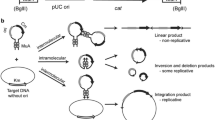Abstract
Most models of DNA transposition invoke replication of the transposable element1, but it is not clear whether a ‘co-integrate’ is an obligatory intermediate in the pathway leading to the production of simple insertions during transposition. Such an intermediate can be accounted for only by a replicative transposition scheme. Bacteriophage Mu is a temperate phage that can either lysogenize or lyse its host2, and it encodes at least two modes of transposition as judged by the end-products generated by the process. During the lytic development of the integrated prophage, co-integrates are the predominant end-products3; transposition is coupled to replication during this phase4. A small number of simple insertions are also produced during the lytic growth3, but during transposition from the infecting phage into the host chromosome, simple insertions are the main end-products5. Conditions can be found where the choice between the two kinds of end-products depends on a delicate balance between the essential transposition functions encoded by Mu6. Experiments7,8 have suggested that the simple insertions which arise during transposition from the infecting phage may do so without Mu DNA replication. Here I demonstrate using an infecting phage with completely methylated DNA, a dam− (DNA adenine methylase) host and a combination of restriction enzymes that can cut either fully methylated or unmethylated DNA but not hemi-methylated DNA, that transposition of the phage DNA into the host chromosome does not involve a duplication of its DNA. This result may also have significance for other transposons9 that do not appear to go through a co-integrate intermediate during transposition10.
Similar content being viewed by others
References
Bukhari, A. I. Trends biochem. Sci. 6, 56–60 (1981).
Bukhari, A. I. A. Rev. Genet. 10, 389–411 (1976).
Chaconas, G., Harshey, R. M., Sarvetnick, N. & Bukhari, A. I. J. molec. Biol. 150, 341–359 (1981).
Ljungquist, E. & Bukhari, A. I. Proc. natn. Acad. Sci. U.S.A. 74, 3143–3147 (1977).
Chaconas, G., Kennedy, D. L. & Evans, D. Virology 128, 48–59 (1983).
Harshey, R. M. Proc. natn. Acad. Sci. U.S.A. 80, 2012–2016 (1983).
Leibart, J. C., Ghelardini, P. & Paolozzi, L. Proc. natn. Acad. Sci. U.S.A. 79, 4362–4366 (1982).
Akroyd, J. E. & Symonds, N. Nature 303, 84–86 (1983).
Berg, D. E. in DNA Insertion Elements, Plasmids and Episomes (eds Bukhari, A. I., Shapiro, J. A. & Adhya, S. L.) 205–212 (Cold Spring Harbor Laboratory, New York, 1977).
Kleckner, N. A. Rev. Genet. 15, 341–404 (1981).
Marinus, M. G. & Morris, R. N. J. Bact. 114, 1143–1150 (1973).
Vovis, G. F. & Lacks, S. J. molec. Biol. 115, 525–538 (1977).
Chow, L. T., Kahmann, R. & Kamp, D. J. molec. Biol. 113, 591–609 (1977).
Brooks, J. E., Blumenthal, R. M. & Gingeras, T. R. Nucleic Acids Res. 11, 837–851 (1983).
Razzaki, T. & Bukhari, A. I. J. Bact. 122, 437–442 (1975).
Miller, H. I. & Freidman, D. I. Cell 20, 711–719 (1980).
Allet, B. Cell 16, 123–129 (1979).
Kahmann, R. & Kamp, D. Nature 280, 247–250 (1979).
Grindley, N. D. F. & Sherratt, D. J. Cold Spring Harb. Symp. quant. Biol. 43, 1257–1261 (1978).
Harshey, R. M. & Bukhari, A. I. J. molec. Biol. 167, 427–441 (1983).
Gill, R., Heffron, F., Dougan, G. & Falkow, S. J. Bact. 136, 742–756 (1978).
Shapiro, J. A. Proc. natn. Acad. Sci. U.S.A. 76, 1933–1937 (1979).
McClintock, B. Cold Spring Harb. Symp. quant. Biol. 16, 13–47 (1951).
Author information
Authors and Affiliations
Rights and permissions
About this article
Cite this article
Harshey, R. Transposition without duplication of infecting bacteriophage Mu DNA. Nature 311, 580–581 (1984). https://doi.org/10.1038/311580a0
Received:
Accepted:
Issue Date:
DOI: https://doi.org/10.1038/311580a0
- Springer Nature Limited
This article is cited by
-
Application of the bacteriophage Mu-driven system for the integration/amplification of target genes in the chromosomes of engineered Gram-negative bacteria—mini review
Applied Microbiology and Biotechnology (2011)
-
The Mugem operon: Its role in gene expression, recombination and cell cycle
Genetica (1994)
-
Suppression of the thermosensitive DNA ligase mutations in Escherichia coli K12 through modulation of gene expression induced by phage Mu
Molecular and General Genetics MGG (1989)
-
Phage Mu transposase: deletion of the carboxy-terminal end does not abolish DNA-binding activity
Molecular and General Genetics MGG (1987)
-
Carboxyl-terminal mutants of phage Mu transposase
Journal of Genetics (1986)




